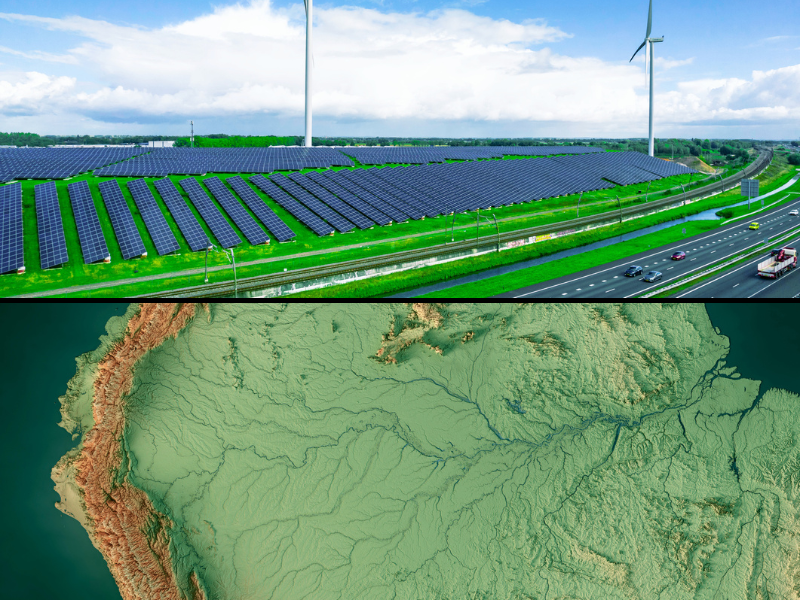A new state-by-state analysis of the cost of transitioning the entire power supply to a 100 percent carbon dioxide emissions-free energy, made up largely of solar and wind power with battery backup, estimates the direct capital costs of such an effort would range between $18 trillion and $29 trillion.
The study by Tom Tanton, director of Science and Technology Assessment at the Energy & Environment Legal Institute, details the capital costs necessary for the “electrification” of the entire nation. Electrification is defined in the study as “converting the entire economy to use electricity as a fuel. This includes all appliances in residential and commercial buildings, as well as every transport vehicle.”
Completely electrifying the economy carries high costs and will result in a less reliable power supply for businesses, consumers, and residents, Tanton argues.
“Electrification of everything is a poor means to reduce greenhouse gasses and exposes customers to more frequent outages,” Tanton writes. “Further, we’d just be substituting one set of environmental impacts for another … and we simply can’t afford to electrify everything as the report clearly shows.”
Tanton estimates the capital cost delivering the current level of demand for electric power from an electric grid powered 100 percent from “renewable” sources like wind or solar power would cost approximately $2.8 trillion.
“To ensure no bias is inadvertently input into the analysis, data come from the Energy Information Administration (EIA),” Tanton said. “This includes the consumption by state per fuel type, as well as technology costs.”
The analysis does not account for anticipated growth in electric power demand.
The cost of converting the country’s entire on-road vehicle fleet to electric vehicles would range between $560 billion and $1.4 trillion, depending on the size of the federal tax credits for the purchase of electric vehicles.
Off-road vehicle replacement, for instance, construction equipment, lawn equipment, loaders, recreational vehicles, and tractors, would cost a further $415 billion. Infrastructure changes necessary in aviation would cost $550 billion, while maritime infrastructure changes would total $200 billion.
The study does not provide estimates for the costs necessary to install batteries and electric motors in every airplane and boat in the country, or necessary to build replacement vessels, let alone provide any commentary over whether doing so is even remotely feasible.
Eliminating natural gas use in buildings would cost $1.6 trillion for residential structures, Tanton argues, and roughly $9 trillion for commercial structures. Tanton notes these cost estimates should be inflated by approximately $7 trillion to account for the excess electric power needed to replace natural gas during extreme weather events “like artic blasts, ‘bomb cyclone,’ ‘polar vortex,’ or extended low temperatures … when the adequacy of the delivery mechanism is most critical to human health and safety.” The facilities generating this emergency load would in effect be hugely expensive stranded costs for most of each year, either being idled or act as spinning reserve, during non-emergency periods of time.
Tanton’s analysis finds, at $3.157 trillion, Texas will experience the highest total electrification costs, followed by California at $2.823 trillion.
By comparison, Tanton calculates completely electrifying the economies of Florida, New York, and Pennsylvania, will costs $1.721 trillion, $1.465 trillion, and $1.156 trillion, respectively. The per capita costs of electrification do not mirror the total state electrification costs. The per capita costs of electrification were the highest in Alaska at $190,009 per capita, followed by Louisiana at $166,065, Wyoming at $158,961, North Dakota at $133,847, and Oklahoma at $122,568. The U.S. average per capita costs were $88,990.
In addition, Tanton estimated that the per-household indirect costs of the higher prices paid for goods and services, if the power supply were to be completely electrified, would top $5,000, and the “annual consumer expenditure for energy would roughly double.”
Tanton found electrifying the economy is a very expensive way to reduce carbon dioxide emissions from energy use, ranging from a low cost of $4,814 per ton of carbon dioxide avoided in New York to a high cost of $28,938 per ton of carbon dioxide avoided in Florida.
By comparison, the U.S. Environmental Protection Agency (EPA) uses the “social cost of carbon,” an estimate of the theoretical damages avoided by reducing one ton of carbon dioxide emissions, to compare policies to cut reduce emissions. Depending on the year cuts begin, the discount rate used in the calculation, the estimate of how sensitive the climate actually is to carbon dioxide emissions, and whether one includes only domestic benefits or global harms avoided as well in the calculation, EPA estimates the harms avoided from reducing a ton of carbon dioxide from the atmosphere range between $11 and $212 per ton.
Legislators should refrain from making any attempt at total electrification, as doing so would have a minimal effect on the environment while simultaneously being extremely expensive, and most of the burden of this shift would fall directly on those lower-income families who could least afford it.
The following documents provide more information about electrification and the high costs of “renewable” energy sources.
Policy Brief: Protecting the Environment from the Green New Deal
https://heartland.org/wp-content/uploads/documents/EnviHarmsPB.pdf
This Heartland Policy Brief by Paul Driessen, policy advisor to the Committee for a Constructive Tomorrow, reviews the largely ignored environmental damage that would result from the expanded use of renewable energy mandated under the Green New Deal.
Policy Brief: The Green New Deal: A Grave Threat to the American Economy, Environment, and Freedom
https://heartland.org/wp-content/uploads/documents/GreenNewDealPB.pdf
The Heartland Policy Brief argues the Green New Deal is a dangerous combination of environmental extremism and socialism. The tremendously expensive proposal would devastate the U.S. economy and cause more environmental destruction than protection. The provisions of the Green New Deal pose a dangerous threat to the American values of individual freedom and limited government.
The 100 Percent Renewable Energy Myth
https://www.instituteforenergyresearch.org/wp-content/uploads/2019/02/Renewable-Myth-Policy-Brief219.pdf
This Policy Brief from the Institute for Energy Research argues that a countrywide 100 percent renewable plan would put the U.S. economy in jeopardy. The brief investigates the intermittency, land requirements, capacity factors, and cost of transition and construction materials that limit the ability of the U.S. to adapt to 100 percent renewable energy.
Legislating Energy Poverty: A Case Study of How California’s and New York’s Climate Change Policies Are Increasing Energy Costs and Hurting the Economy
https://www.pacificresearch.org/wp-content/uploads/2018/12/LegislatingEnergy_F_Web.pdf
This analysis from Wayne Winegarden of the Pacific Research Institute shows the big government approach to fighting climate change taken by California and New York hits working class and minority communities the hardest. The paper reviews the impact of global warming policies adopted in California and New York, such as unrealistic renewable energy goals, strict low carbon fuel standards, and costly subsidies for buying higher-priced electric cars and installing solar panels. The report finds that, collectively, these expensive and burdensome policies are dramatically increasing the energy burdens of their respective state residents.
The U.S. Leads the World in Clean Air: The Case for Environmental Optimism
https://files.texaspolicy.com/uploads/2018/11/27165514/2018-11-RR-US-Leads-the-World-in-Clean-Air-ACEE-White.pdf
This paper from the Texas Public Policy Foundation examines how the United States achieved robust economic growth while dramatically reducing emissions of air pollutants. The paper states that these achievements should be celebrated as a public policy success story, but instead the prevailing narrative among political and environmental leaders is one of environmental decline that can only be reversed with a more stringent regulatory approach. Instead, the paper urges for the data to be considered and applied to the narrative.
America’s Progress at Risk: An Economic Analysis of a Ban on Fracking and Federal Leasing for Natural Gas and Oil Development
https://www.api.org/~/media/Files/Oil-and-Natural-Gas/Hydraulic-Fracturing/2020/fracking-ban-study-americas-progress-at-risk.pdf
The study from the American Petroleum Institute (conducted by economic modeling firm OnLocation) warns that banning federal leasing and fracking on public and private lands, which some presidential candidates have proposed, would cost up to 7.5 million American jobs in 2022 alone, lead to a cumulative GDP loss of $7.1 trillion by 2030, slash household incomes by $5,400 annually, increase household energy costs by more than $600 per year and reduce farm incomes by 43 percent due to higher energy costs. If a ban is enacted, the U.S. would flip from being a net exporter of oil and petroleum products to importing more than 40 percent of supplies by 2030
What If…Hydraulic Fracturing Were Banned? (2020 Edition)
https://www.globalenergyinstitute.org/sites/default/files/2019-12/hf_ban_report_final.pdf
This study from the Global Energy Institute at the U.S. Chamber of Commerce says a ban on fracking in the United States would be catastrophic for our economy. Their analysis shows that if such a ban were imposed in 2021, by 2025 it would eliminate 19 million jobs and reduce U.S. Gross Domestic Product by $7.1 trillion. Tax revenue at the local, state, and federal levels would decline by nearly a combined $1.9 trillion. Natural gas prices would leap by 324 percent, causing household energy bills to more than quadruple. By 2025, motorists would pay twice as much at the pump for gasoline as oil prices spike to $130 per barrel, while less domestic energy production would also mean less energy security.
Climate Change Reconsidered II: Fossil Fuels – Summary for Policymakers
https://heartland.org/publications-resources/publications/climate-change-reconsidered-ii-fossil-fuels—summary-for-policymakers
In this fifth volume of the Climate Change Reconsidered series, 117 scientists, economists, and other experts assess the costs and benefits of the use of fossil fuels by reviewing scientific and economic literature on organic chemistry, climate science, public health, economic history, human security, and theoretical studies based on integrated assessment models (IAMs) and cost-benefit analysis (CBA).
The Social Benefits of Fossil Fuels
https://heartland.org/publications-resources/publications/the-social-benefits-of-fossil-fuels
This Heartland Policy Brief by Joseph Bast and Peter Ferrara documents the many benefits from the historic and still ongoing use of fossil fuels. Fossil fuels are lifting billions of people out of poverty, reducing all the negative effects of poverty on human health, and vastly improving human well-being and safety by powering labor-saving and life-protecting technologies, such as air conditioning, modern medicine, and cars and trucks. They are dramatically increasing the quantity of food humans produce and improving the reliability of the food supply, directly benefiting human health. Further, fossil fuel emissions are possibly contributing to a “Greening of the Earth,” benefiting all the plants and wildlife on the planet.
Nothing in this Research & Commentary is intended to influence the passage of legislation, and it does not necessarily represent the views of The Heartland Institute. For further information on this subject, visit Environment & Climate News, The Heartland Institute’s website, and PolicyBot, Heartland’s free online research database.
The Heartland Institute can send an expert to your state to testify or brief your caucus; host an event in your state; or send you further information on a topic. Please don’t hesitate to contact us if we can be of assistance! If you have any questions or comments, contact Heartland’s Government Relations department, at [email protected] or 312/377-4000.




